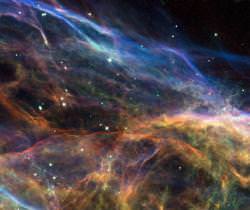Now this is one of the coolest images I’ve seen captured by the Hubble Space Telescope in a long time. It’s just a portion of the Veil Nebula; all that remains from a star that exploded about 5-10,000 years ago.
The star that created this wreckage was once much larger than our own Sun. Instead of dying out to a white dwarf – the fate for our Sun – it detonated as a supernova. The explosion swept out a huge bubble in its surroundings, heating up gas and dust, and becoming visible in our telescopes.
The Veil Nebula is huge. The entire shell covers about 3 degrees of the sky. That’s the same amount as 6 full moons. So these images captured by Hubble only reveal tiny portions of it. If you follow along to the original press release, you’ll see a series of 8 images in total, each focused on a different part of the nebula.
Scientists think that the original star exploded 5-10,000 years ago, and would have been seen by ancient civilizations. Anyone fortunate enough to be alive then would have seen light from the star increase until it was as bright as a crescent moon. But all this light would be streaming from a single point source. Amazing.
If you want to see the Veil Nebula for yourself, it’s located in the constellation of Cygnus, the Swan. The brightest star in the region is named 52 Cygni, and can be seen with the unaided eye on a dark night. You’ll need binoculars to see a hazy bit where the nebula is, and and a nice telescope to reveal more.
Original Source:ESA Hubble News Release

